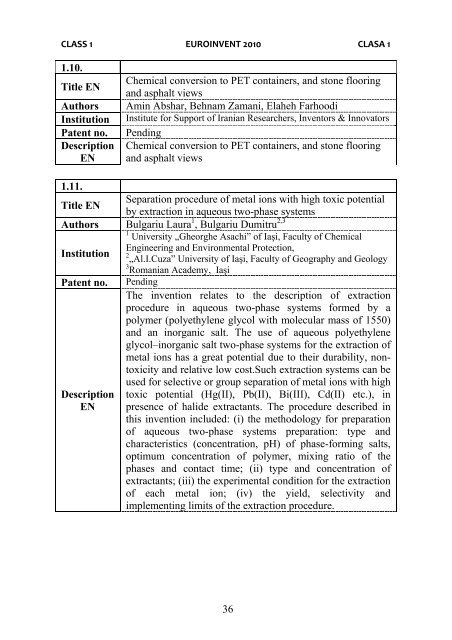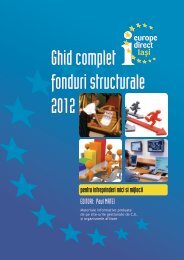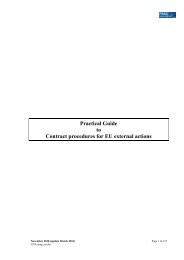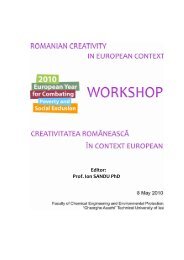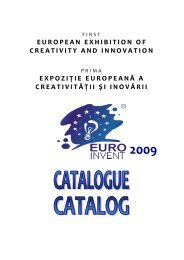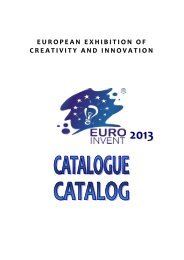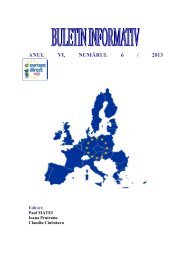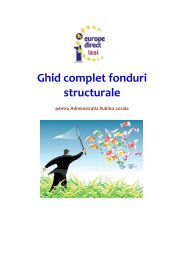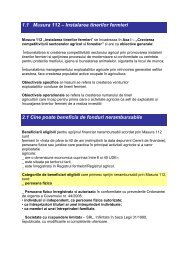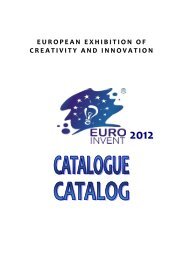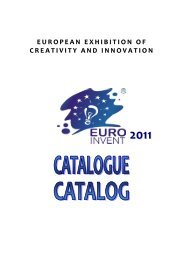Download - Europe Direct Iasi
Download - Europe Direct Iasi
Download - Europe Direct Iasi
Create successful ePaper yourself
Turn your PDF publications into a flip-book with our unique Google optimized e-Paper software.
CLASS 1 EUROINVENT 2010 CLASA 1<br />
1.10.<br />
Title EN<br />
Chemical conversion to PET containers, and stone flooring<br />
and asphalt views<br />
Authors Amin Abshar, Behnam Zamani, Elaheh Farhoodi<br />
Institution Institute for Support of Iranian Researchers, Inventors & Innovators<br />
Patent no. Pending<br />
Description<br />
EN<br />
Chemical conversion to PET containers, and stone flooring<br />
and asphalt views<br />
1.11.<br />
Separation procedure of metal ions with high toxic potential<br />
Title EN<br />
by extraction in aqueous two-phase systems<br />
Authors Bulgariu Laura 1 , Bulgariu Dumitru 2,3<br />
1<br />
University „Gheorghe Asachi” of Iaşi, Faculty of Chemical<br />
Engineering and Environmental Protection,<br />
Institution 2<br />
„Al.I.Cuza” University of Iaşi, Faculty of Geography and Geology<br />
3<br />
Romanian Academy, Iaşi<br />
Patent no.<br />
Description<br />
EN<br />
Pending<br />
The invention relates to the description of extraction<br />
procedure in aqueous two-phase systems formed by a<br />
polymer (polyethylene glycol with molecular mass of 1550)<br />
and an inorganic salt. The use of aqueous polyethylene<br />
glycol–inorganic salt two-phase systems for the extraction of<br />
metal ions has a great potential due to their durability, nontoxicity<br />
and relative low cost.Such extraction systems can be<br />
used for selective or group separation of metal ions with high<br />
toxic potential (Hg(II), Pb(II), Bi(III), Cd(II) etc.), in<br />
presence of halide extractants. The procedure described in<br />
this invention included: (i) the methodology for preparation<br />
of aqueous two-phase systems preparation: type and<br />
characteristics (concentration, pH) of phase-forming salts,<br />
optimum concentration of polymer, mixing ratio of the<br />
phases and contact time; (ii) type and concentration of<br />
extractants; (iii) the experimental condition for the extraction<br />
of each metal ion; (iv) the yield, selectivity and<br />
implementing limits of the extraction procedure.<br />
36


